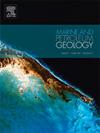哥伦比亚东部陆表海-拉月海末期沉积体系的坎帕尼亚-马斯特里赫特演化:过程、时空变异和沉积控制
IF 3.6
2区 地球科学
Q1 GEOSCIENCES, MULTIDISCIPLINARY
引用次数: 0
摘要
在白垩纪,与全球海平面上升有关的表海分布广泛。这些地区的地层记录主要受沉积、构造和气候等因素的控制,形成了重要的烃源岩和储集岩。在南美洲-哥伦比亚的西北部,有一个早白垩世形成的表海,即晚白垩世的La Luna海,其西面以火山弧为界,东面以亚马逊克拉通为界,在坎帕尼亚-马斯垂克期逐渐被填满,成为这些晚白垩世沉积的重要油气储层。坎帕尼亚—早马夏期盆地西侧和中部为正常滨面剖面,以远洋和波浪沉积作用为主,东侧为以河流沉积作用为主的三角洲剖面。在马斯特里赫特晚期,与西加勒比地体增生直接相关的是,在盆地两侧建立了以河流作用为主的过渡性和陆相环境,表明出露地区的地貌地形和排水系统特征发生了变化,导致了表相盆地的填充。矿床的分布受异源作用的控制:与原中部科迪勒拉生长有关的构造作用、全球海平面上升水平,以及较小程度的自生作用,如河道崩裂、底流和沿岸流以及高生产力事件。这些过程及其变化的时空影响是造成盆地两侧沉积类型不同的原因,直接影响了大型底栖生物群落的建立,也为储层相关勘探提供了新的思路。比较表明,接收带和出出带的大小对盆地沿岸和整个盆地的沉积物分布和排列起着重要作用,这与沉积物再分配所涉及的内部过程的性质有关。本文章由计算机程序翻译,如有差异,请以英文原文为准。
Campanian-Maastrichtian evolution of sedimentary systems during the final stages of an epeiric sea —La Luna Sea— in eastern Colombia: Processes, spatio-temporal variability, and depositional controls
Epeiric seas were widespread during the Cretaceous, associated with global sea-level rise. Their stratigraphic record, controlled mainly by eustasy, tectonic and climatic factors, resulted in the accumulation of important hydrocarbon source and reservoir rocks. In the NW of South America-Colombia, an epeiric sea established in the Early Cretaceous—knows as La Luna Sea in the Late Cretaceous—, bounded by a volcanic arc to the western side and by the Amazonian Craton to the east, was progressively filled during the Campanian-Maastrichtian, being these latest Cretaceous deposits important hydrocarbon reservoirs for conventional petroleum systems. In the Campanian-early Maastrichtian period the western side and the central part of the basin had a normal shoreface profile, dominated by pelagic and wave sedimentation processes, while a delta profile dominated by fluvial processes characterized the eastern side. During the late Maastrichtian, directly related to the accretion of western Caribbean terranes, transitional and continental environments dominated by fluvial processes were established on both sides of the basin, suggesting changes in geomorphological-topographic and drainage system characteristics of the emerged areas, leading to the filling of the epeiric basin. The distribution of the deposits was controlled by allogenic processes: tectonism associated with the growth of the proto-Central Cordillera, the global eustatic level, and in minor degree by autogenic processes such as channel avulsion, bottom and longshore currents, and high productivity events. These processes and their variable temporal and spatial influence were responsible for the different types of deposits on either side of the basin, which had a direct impact on the establishment of macrobenthic communities, also providing new exploration ideas related to the reservoirs.
Comparisons suggest that the size of the receiving and emerged zones plays an important role in the distribution and arrangement of deposits along and across the basin, related to the nature of the internal processes involved in sediment redistribution.
求助全文
通过发布文献求助,成功后即可免费获取论文全文。
去求助
来源期刊

Marine and Petroleum Geology
地学-地球科学综合
CiteScore
8.80
自引率
14.30%
发文量
475
审稿时长
63 days
期刊介绍:
Marine and Petroleum Geology is the pre-eminent international forum for the exchange of multidisciplinary concepts, interpretations and techniques for all concerned with marine and petroleum geology in industry, government and academia. Rapid bimonthly publication allows early communications of papers or short communications to the geoscience community.
Marine and Petroleum Geology is essential reading for geologists, geophysicists and explorationists in industry, government and academia working in the following areas: marine geology; basin analysis and evaluation; organic geochemistry; reserve/resource estimation; seismic stratigraphy; thermal models of basic evolution; sedimentary geology; continental margins; geophysical interpretation; structural geology/tectonics; formation evaluation techniques; well logging.
 求助内容:
求助内容: 应助结果提醒方式:
应助结果提醒方式:


